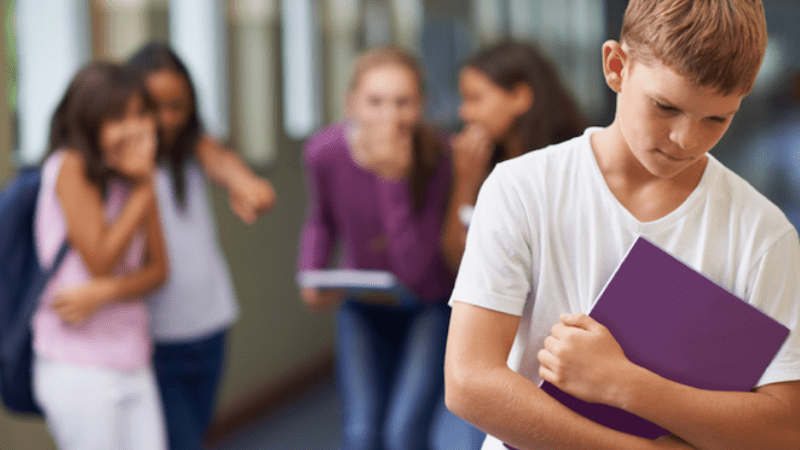When a student is pushed in the lunchroom or otherwise physically bullied, it’s a clear case for intervention. But it can be trickier to know how to handle more subtle hostile behavior—or microaggressions. While not always targeting an individual, these verbal barbs or actions often disparage a particular group and can contribute to an unhealthy school climate.
Here’s what teachers should know about microaggressions so they can effectively address this toxic behavior at different ages before it turns into bullying:
-
Microaggressions are often linked to language.
Behavior that might not look like bullying, but communicates hostile or derogatory attitudes toward a particular group—by race, sexual orientation or disability—can be microaggressions. They may be spoken words that obviously victimize, such using the word “retard” or referring to something as “gay.” But linguistic microaggressions take subtler turns, too. Continually mispronouncing a student’s name can be considered a microaggression, for example. So can making assumptions about a student’s background. You’re Hispanic! What do you mean you don’t speak Spanish? Here’s a list of other common microagressions that happen in schools.
You can make a difference by being aware of the words you use, what your students are saying, and by providing corrective feedback about what is and isn’t appropriate, says Jessica Toste, assistant professor in the Department of Special Education at the University of Texas in Austin. It’s about being conscious of how our language has an impact on everyone in the classroom.
-
Exclusive actions can also be harmful.
Microaggressions can also be actions that exclude or tear down certain people—sometimes without the intent to harm, although that’s the result. For instance, for someone in a wheelchair it can be a microaggression for the class to arrange a field trip to a location that is not accessible. Having gendered bathrooms or activities can have a negative impact on transgendered students. “It’s not targeting [those students] in any way or trying to make them feel bad, but it’s something that can have a huge impact on them as they have to maneuver that situation,” says Toste.
-
Teachers can set the tone.
It’s important for teachers to set up a classroom community where diversity and differences are not only accepted, but celebrated, say Toste. Stigmas and negative perceptions can be diminished when teachers talk with students. “Be open that people need different things to learn and to be successful. We all come from different experiences and have different strengths,” says Toste. “Sometimes we try to just make everything feel exactly equal without recognizing the fact that we all need different things.”
-
Inclusive curriculum can create acceptance.
Include literature and have conversations around various kinds of family structures, identities, and backgrounds, suggests Toste. “Never representing a family structure that is similar to one lived in by a kid in the class can be difficult for them,” she says. Check out educator resources for the classroom from the Oleweus Bullying Program.
-
Be aware of gender identity and sexuality issues.
Microaggressions are often linked to gender or sexuality. Rather than assuming all students want to date someone of the opposite sex—or date at all—a supportive school environment is sensitive to hosting activities such as a “Sadie Hawkins” dance, for example, and responsive to the needs of all students, says Toste.
-
Kids are looking for a response.
Bullying is like a ladder that kids climb, testing out their skills along the way. And the first rung is microaggressions, says Jan Urbanski, director of Safe and Humane Schools at Clemson University. “Whether intentional or not, microaggressions can cause and perpetuate a power imbalance based on gender, race, ethnicity, religion, or other identity status,” she says. “When these aggressive behaviors are not systematically addressed, patterns of bullying may emerge. If unchecked, they can also create a climate that allows bullying to happen.”
-
Relationships can be used as weapons.
Relational microaggressions happen when someone intentionally embarrasses another person—often with some form of gossip—designed to isolate or humiliate them, say Paul Coughlin, founder and president of The Protectors, a nonprofit anti-bullying organization based in Medford, Oregon. A bully can appear friendly to the victim, but the friendship is actually highly conditional and if the victim is dropped the hurt can be profound. Teachers should be aware of this, particularly in middle school, and be available to support students who are victimized.
-
Include parents in the issue.
“Bullying is a cultural problem, not a school problem,” says Coughlin. “Schools are unfairly saddled with solving it. They do not have all the tools necessary for this topic. Parents are the frontline defense.” Host special evening programs to talk about bullying and microaggressions with parents and encourage them to continue the dialogue at home to convey positive parental expectations to do the right thing.
-
Make it cool to be courageous.
Teachers are limited in what they can do when kids say cruel things, admits Coughlin, but they can help promote the idea that it’s “cool to be courageous” and empower others to speak up when they hear hostile behavior. The ones with power and who bully are often the popular kids. “Cruelty, meanness and unkindness are currency. You get ahead socially by being awful,” says Coughlin. “We have to make civil courage a currency in school settings.”
-
Empowering bystanders is key.
Bystanders need scripts to follow—non-violent words—that can denounce the behavior. Teachers and parents can encourage kids to intervene, report what they heard, and comfort the victim afterwards. Helping someone in need can actually help children develop a strong character and capacity for leadership. “There is no neutrality when it comes to bullying. We are affected when we witness it,” says Coughlin. “If we can get our kids to stand up against bullying, we are going to that make our schools better and grow greater civility in the American population.”


